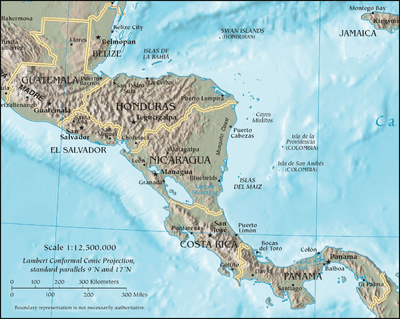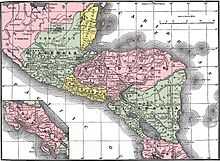History of Central America

| Part of a series on |
| Central America |
|---|
 |
|
Countries |
|
Culture |
|
Economy |
|
Education |
|
Environment
|
|
Politics and government |
|
Transportation |
|
Related topics |
The history of Central America is the study of the region known as Central America.
Before European contact
In pre-Columbian times, most of modern Central America was part of the Mesoamerican civilization. The Native American societies of Mesoamerica occupied the land ranging from central Mexico in the north to Northern Costa Rica in the south. The pre-Columbian cultures of the rest of Costa Rica and Panama traded with both Mesoamerica and South America, and can be considered transitional between those two cultural areas.
Spanish Colonial Era
Central America is composed of seven independent nations: Belize, Costa Rica, El Salvador, Guatemala, Honduras, Nicaragua and Panama. After the Spanish conquest in the 16th century, most of the inhabitants of Central America shared a similar history. The exception was the Western Caribbean Zone, which included the Caribbean coast and encompassed both semi-independent indigenous polities, runaway slave communities, and settlers, especially British settlers who would eventually form British Honduras (the modern-day nation of Belize), a sparsely populated area that was inhabited by the British through the Treaty of Madrid from Spain. When Spain failed to regain control over British Honduras, the British continued to inhabit the country, and eventually colonized it. When Guatemala gained its independence, they assumed inheritance of British Honduras from Spain. British Honduras had been a British settlement, not a Colony (the treaty between Spain and The United Kingdom prohibited British Colonies in the territory)for several years. After many years of controversy, a treaty was signed between Guatemala and the United Kingdom in which the Guatemalan President of the time recognized the original territory (granted by the kingdom of Spain to the British Crown) of Belize. Within this treaty, was also an agreement that a cart road be built from Guatemala City through British Honduras to the Caribbean Sea. Since the cart road was never built, Guatemala declared the treaty null and void. British Honduras for the British and Belice for the Spaniards and Guatemalans gained its independence from Great Britain in 1981 and adopted the name "Belize". Guatemala still disputes the Belizean Territory.
From the 16th century through 1821, Central America formed the Captaincy General of Guatemala, sometimes known also as the Kingdom of Guatemala, composed by a part of the state of Chiapas (nowadays Mexico), Guatemala, El Salvador, Honduras, Nicaragua, and Costa Rica. Officially, the Captaincy was part of the Viceroyalty of New Spain and therefore under the supervision of the Spanish viceroy in Mexico City. It was, however, administered not by the viceroy or his deputies, but by an independently appointed Captain General headquartered first in Antigua Guatemala and later in Guatemala City.
Independence
In 1811, independence movements broke out in El Salvador in reaction to events in the Peninsular War, and again in 1814 after the restoration of Ferdinand VII. Both revolts were easily suppressed and the political unrest was subsumed into the general political process in the Spanish world that led to the Spanish Constitution of 1812. Between 1810 and 1814, the Captaincy General elected seven representatives to the Cádiz Cortes, in addition to forming a locally-elected Provincial Deputation.[1] In 1821 a congress of Central American Criollos in Guatemala City composed the Act of Independence of Central America to declared the region's independence from Spain, effective on 15 September of that year.[2] That date is still marked as independence day by most Central American nations. The Spanish Captain General, Gabino Gaínza, sympathized with the rebels and it was decided that he should stay on as interim leader until a new government could be formed. Independence was short-lived, for the conservative leaders in Guatemala welcomed annexation by the First Mexican Empire of Agustín de Iturbide on 5 January 1822. Central American liberals objected to this, but an army from Mexico under General Vicente Filisola occupied Guatemala City and quelled dissent.
When Mexico became a republic the following year, it acknowledged Central America's right to determine its own destiny. On 1 July 1823, the congress of Central America declared absolute independence from Spain, Mexico, and any other foreign nation, including North America and a Republican system of government was established.
 Coat of arms of the United Provinces of Central America in 1823. |
 Central America, 1892 |
United Provinces of Central America
In 1823, the nation of Central America was formed. It was intended to be a federal republic modeled after the United States of America. It was provisionally known as "The United Provinces of Central America," while the final name according to the Constitution of 1824 was "The Federal Republic of Central America." It is sometimes incorrectly referred in English as "The United States of Central America." The Central American nation consisted of the states of Guatemala, El Salvador, Honduras, Nicaragua, and Costa Rica. In the 1830s, an additional state was added, Los Altos, with its capital in Quetzaltenango, occupying parts of what is now the western highlands of Guatemala and part of Chiapas (now part of Mexico), but this state was reincorporated into Guatemala and Mexico respectively in 1840.
Central American liberals had high hopes for the federal republic, which they believed would evolve into a modern, democratic nation, enriched by trade crossing through it between the Atlantic and the Pacific oceans. These aspirations are reflected in the emblems of the federal republic: The flag shows a white band between two blue stripes, representing the land between two oceans. The coat of arms shows five mountains (one for each state) between two oceans, surmounted by a Phrygian cap, the emblem of the French Revolution.
The Union dissolved in civil war between 1838 and 1840. Its disintegration began when Nicaragua separated from the federation on November 5, 1838.
Greater Republic of Central America
Various attempts were made to reunite Central America in the 19th century, but none succeeded for any length of time:
- The first attempt was in 1842 by former President Francisco Morazán, who was quickly captured and executed. The abortive attempt proposed to restore the union as the Confederation of Central America and planned to include El Salvador, Guatemala, Honduras, and Nicaragua. This first attempt lasted until 1844.
- A second attempt was made and lasted from October to November 1852, when El Salvador, Honduras and Nicaragua created a Federation of Central America (Federacion de Centro America).
- Guatemalan President Justo Rufino Barrios attempted to reunite the nation by force of arms in the 1880s and was also killed in the process, like his 1842 predecessor.
- A third union of Honduras, Nicaragua, and El Salvador as the Greater Republic of Central America or "Republica Mayor de Centroamerica" lasted from 1896 to 1898.
- The last attempt occurred between June 1921 and January 1922 when El Salvador, Guatemala, Honduras and Costa Rica formed a (second) Federation of Central America. The treaty establishing this federation was signed at San José, Costa Rica on January 19, 1921. This second Federation was nearly moribund from the start, having only a Provisional Federal Council made up of delegates from each state.
Despite the failure of a lasting political union, the concept of Central American reunification, though lacking enthusiasm from the leaders of the individual countries, rises from time to time. In 1856-1857, the region successfully established a military coalition to repel an invasion by U.S. adventurer William Walker. Today, all five nations fly flags that retain the old federal motif of two outer blue bands bounding an inner white stripe. (Costa Rica, traditionally the least committed of the five to regional integration, modified its flag significantly in 1848 by darkening the blue and adding a double-wide inner red band, in honor of the French tricolor).
20th century
In 1907, a Central American Court of Justice was created. On December 13, 1960, Guatemala, El Salvador, Honduras, and Nicaragua established the Central American Common Market ("CACM"). Costa Rica, because of its relative economic prosperity and political stability, chose not to participate in the CACM. The goals for the CACM were to create greater political unification and success of import substitution industrialization policies. The project was an immediate economic success, but was abandoned after the 1969 "Football War" between El Salvador and Honduras.
A Central American Parliament has operated, as a purely advisory body, since 1991. Costa Rica has repeatedly declined invitations to join the regional parliament, which seats deputies from the four other former members of the Union, as well as from Panama and the Dominican Republic.
Another initiative is known as Free Movement of Persons in the CA-4, which has opened the borders between Nicaragua and Guatemala removing the need to carry a passport to cross borders, just a national ID (cédula de identidad) is enough to cross borders. This initiative is the result of negotiations of the Central American Commission of Directors of Migration (OCAM) with the support of the International Organization for Migration (IOM). This initiative has been in effect since 2007.
History of Central American Nations
- History of Belize
- History of Costa Rica
- History of El Salvador
- History of Guatemala
- History of Honduras
- History of Nicaragua
- History of Panama
References
- ↑ Marie Laure Rieu-Millan. Los diputados americanos en las Cortes de Cádiz: Igualdad o independencia. Madrid: Consejo Superior de Investigaciones Científicas, 1990, 43. ISBN 978-84-00-07091-5
- ↑ "Documentos de la Union Centroamericana" (PDF). Organization of American States - Foreign Trade Information System. Retrieved 12 October 2014.
Further reading
- Booth, John A., Christine J. Wade, and Thomas Walker, eds. Understanding Central America: Global Forces, Rebellion, and Change (Westview Press, 2014)
- Coatsworth, John H. Central America and the United States: the clients and the `colossus (Twayne Pub, 1994)
- LaFeber, Walter. Inevitable Revolutions: The United States in Central America (2nd edition). New York, Norton & Company, 1993. ISBN 978-0-393-01787-8
- LeoGrande, William M. Our Own Backyard: The United States in Central America, 1977-1992 (Univ of North Carolina Press, 1998) Online edition
| Wikimedia Commons has media related to History of Central America. |